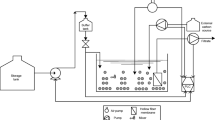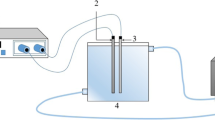Abstract
The removal of polycyclic aromatic hydrocarbons by membrane bioreactor (MBR) under aerobic conditions had been studied using naphthalene (NAP) and phenanthrene (PHE) as model compounds. Three MBRs with submerged ultra-filtration hollow fiber membranes were operated applying different operational conditions during 6.5 months. Complete NAP and PHE removal was obtained applying loads of 7 gNAP kgTSS−1 day−1 and 0.5 gPHE kgTSS−1 day−1, while the organic loading rate was adjusted to 0.26 kgCOD kgTSS−1 day−1, with the biomass concentration being 6000 mgTSS L−1, the hydraulic retention time (HRT) 8 h and the solids retention time (SRT) 30 days. Load increases, as well as HRT and SRT reductions, affected the NAP and PHE removals. Biodegradation was found to be the major NAP and PHE removal mechanism. There was no NAP accumulation in the biomass. Low PHE quantities remain sorbed in the biomass and the contribution of the sorption in the removal of this compound was estimated to be less than 0.01 %. The volatilization does not contribute to the PHE removal in MBRs, but the contribution of NAP volatilization can reach up to 0.6 % when HRT of 8 h is applied.





Similar content being viewed by others
References
Akcha F, Burgeot T, Narbonne JF, Garrigues P (2003) Metabolic Activation of PAHs: Role of DNA Adduct Formation in Induced Carcinogenesis. In: Douben PET (ed) PAHs: an ecotoxicological perspective., Ecological and environmental toxicology seriesWiley, New York, pp 65–80
Andersson BE, Lundstedt S, Tornberg K, Schnürer Y, Öberg LG, Mattiasson B (2003) Incomplete degradation of polycyclic aromatic hydrocarbons in soil inoculated with wood-rotting fungi and their effect on the indigenous soil bacteria. Environ Toxicol Chem 22:1238–1243
APHA (2012) Standard methods for the examination of water and wastewater, 22nd edn. American Public Health Association (APHA-AWWA-WEF), Washington, DC
Ball A, Truskewycz A (2013) Polyaromatic hydrocarbon exposure: an ecological impact ambiguity. Environ Sci Pollut Res 20:4311–4326
Bamforth SM, Singleton I (2005) Bioremediation of polycyclic aromatic hydrocarbons: current knowledge and future directions. J Chem Technol Biotechnol 80:723–736
Blanchard M, Teil MJ, Ollivon D, Legenti L, Chevreuil M (2004) Polycyclic aromatic hydrocarbons and polychlorobiphenyls in wastewaters and sewage sludges from the Paris area (France). Environ Res 95:184–197
Buitron G, Razo-Flores E, Meraz M, Alatriste Mondragon F (2006) Biological treatment systems. In: Cervantes F, Pavlostathis SG, van Haandel AC (eds) Advanced Biological treatment processes for industrial wastewater. Principles and applications. IWA Publishing, London, pp 141–185
Busetti F, Heitz A, Cuomo M, Badoer S, Traverso P (2006) Determination of sixteen polycyclic aromatic hydrocarbons in aqueous and solid samples from an Italian wastewater treatment plant. J Chromatogr A 1102:104–115
Byrns G (2001) The fate of xenobiotic organic compounds in wastewater treatment plants. Water Res 35:2523–2533
Cai QY, Mo CH, WU QT, Zeng QY, Katsoyiannis A (2007) Occurrence of organic contaminants in sewage sludges from eleven wastewater treatment plants, China. Chemosphere 68:1751–1762
Chauhan A, Fazlurrahman OJ, Jain R (2008) Bacterial metabolism of polycyclic aromatic hydrocarbons: strategies for bioremediation. Indian J Microbiol 48:95–113
Clara M, Kreuzinger N, Strenn B, Gans O, Kroiss H (2005) The solids retention time a suitable design parameter to evaluate the capacity of wastewater treatment plants to remove micropollutants. Water Res 39:97–106
Dosoretz CG, Böddeker KW (2004) Removal of trace organics from water using a pumped bed-membrane bioreactor with powdered activated carbon. J Membr Sci 239:81–90
European Union Decision 2455/2001/EC (2001) EU Decision of the European Parliament and of the Council, Official Journal of European Union, vol. L331, pp. 1–5
Fatone F, Di Fabio S, Bolzonella D, Cecchi F (2011) Fate of aromatic hydrocarbons in Italian municipal wastewater systems: an overview of wastewater treatment using conventional activated-sludge processes (CASP) and membrane bioreactors (MBRs). Water Res 45:93–104
González D, Ruiz LM, Garralón G, Plazab F, Arévalo J, Parada J, Pérez J, Moreno B, Gómez MA (2012) Wastewater polycyclic aromatic hydrocarbons removal by membrane bioreactor. Desalin Water Treat 42:94–99
Goodson KL, Pit R, Clark S (2015) PAHs in wastewater during dry and wet weather. In: Forsgren AJ (ed) Wastewater Treatment: Occurrence and Fate of Polycyclic Aromatic Hydrocarbons (PAHs)., Advances in water and wastewater transport and treatmentCRC Press, Boca Raton, pp 157–175
Haritash AK, Kaushik CP (2009) Biodegradation aspects of polycyclic aromatic hydrocarbons (PAHs): a review. J Hazard Mater 169:1–15
Irwin RJ, VanMouwerik M, Stevens L, Seese MD, Basham W (1997) Environmental Contaminants Encyclopedia. National Park Service, Water Resources Division, Fort Collins, Colorado, Phenanthrene entry, p 18
Jiries A, Hussan H, Lintelmann J (2000) Determination of polycyclicaromatic hydrocarbons in wastewater, sediments, sludge and plants in Karak Province, Jordan. Water Air Soil Pollut 121:217–228
Kanaly RA, Harayama S (2000) Biodegradation of high-molecular-weight polycyclic aromatic hydrocarbons by bacteria. J Bacteriol 182:2059–2067
Katsoyiannis A, Samara C (2004) Persistent organic pollutants (POPs) in the sewage treatment plant of Thessaloniki, northern Greece: occurrence and removal. Water Res 38:2685–2698
Katsoyiannis A, Zouboulis A, Samara C (2006) Persistent organic pollutants (POPs) in the conventional activated sludge treatment process: model predictions against experimental values. Chemosphere 65:1634–1641
Kochany J (2015) PAHs in natural waters: natural and anthropogenic sources, and environmental behavior. In: Forsgren AJ (ed) Wastewater treatment: occurrence and fate of polycyclic aromatic hydrocarbons (PAHs)., Advances in water and wastewater transport and treatmentCRC Press, Boca Raton, pp 11–47
Lau KL, Tsang YY, Chiu SW (2003) Use of spent mushroom compost to bioremediate PAH-contaminated samples. Chemosphere 52:1539–1546
Lofrano G, Nikolaou A, Kostopoulou Pagano G, Belgiorno V, Napoli RMA (2009) Occurrence and measurement of organic xenobiotic compounds in harbour and coastal sediments. In: Kassinos D, Bester K, Kümmerer K (eds) Xenobiotics in the urban water cycle: mass flows, environmental processes, mitigation and treatment strategies. Springer, Dordrecht Heidelberg London New York, pp 129–146
Lundstedt S, Haglund P, Öberg L (2003) Degradation and formation of polycyclic aromatic compounds during bioslurry treatment of an aged gasworks soil. Environ Toxicol Chem 22:1413–1420
Melin T, Jefferson B, Bixio D, Thoeye C, DeWilde W, De Koning J, Van der Graaf J, Wintgens T (2006) Membrane bioreactor technology for wastewater treatment and reuse. Desalination 187:271–282
Mozo I, Stricot M, Lesage N, Spérandio M (2011) Fate of hazardous aromatic substances in membrane bioreactors. Water Res 45:4551–4561
Mozo I, Lesage G, Yin J, Bessiere Y, Barna L, Sperandio M (2012) Dynamic modeling of biodegradation and volatilization of hazardous aromatic substances in aerobic bioreactor. Water Res 46:5327–5342
Panizza M, Bocca C, Cerisola G (2000) Electrochemical treatment of wastewater containing polyaromatic organic pollutants. Water Res 34:2601–2605
Payne JF, Mathieu A, Collier TK (2003) Ecotoxicological Studies Focusing on Marine and Freshwater Fish. In: Douben PET (ed) PAHs: an ecotoxicological perspective., Ecological and environmental toxicology seriesWiley, New York, pp 191–224
Rosenberger S, Kruger U, Witzig R, Manz W, Szewzyk U, Kraume M (2002) Performance of a bioreactor with submerged membranes for aerobic treatment of municipal wastewater. Water Res 36:413–420
Samanta SK, Singh OM, Jain RK (2002) Polycyclic aromatic hydrocarbons: environmental pollution and bioremediation. Trends Biotechnol 20:243–248
Singh A, Kuhad RC, Ward OP (2009) Advances in applied bioremediation, vol 17. Springer, Berlin
Sponza DT, Gok O (2011) Effects of sludge retention time and biosurfactant on the treatment of polyaromatic hydrocarbon (PAH) in a petrochemical industry wastewater. Water Sci Technol 64:2282–2292
Stephenson T, Judd S, Jefferson B, Brindle K (2000) Membrane bioreactors for wastewater treatment. IWA Publishing, London
Storm T, Reemtsma T, Jekel M (1999) Use of volatile amines as ion-pairing agents for the high performance liquid chromatographic–tandem mass spectrometric determination of aromatic sulfonates in industrial wastewater. J Chromatogr A 854:175–185
Tikilili PV, Chirwa EMN (2011) Characterization and biodegradation of polycyclic aromatic hydrocarbons in radioactive wastewater. J Hazard Mater 192:1589–1596
Torretta V (2015) PAHs in wastewater and removal efficiency in conventional wastewater treatment plants. In: Forsgren AJ (ed) Wastewater treatment: occurrence and fate of polycyclic aromatic hydrocarbons (PAHs)., Advances in water and wastewater transport and treatmentCRC Press, Series, pp 141–156
US EPA (1990) Treatibility manual. EPA 540/2-90-007, Washington DC 20460
US EPA (2003) US EPA Code of Federal Regulations 2003e 40 CFR 268.48
Water Framework Directive (2000) Directive 2000/60/EC of the European Parliament and of Council of 23 October 2000 establishing a framework for community action in the field of water policy. Off J Eur Communities 327:1–72
Zhang W, Wei C, Yan B, Feng C, Guobao Z, Lin C, Yuan M, Chaofei W, Ren Y, Hu Y (2013) Identification and removal of polycyclic aromatic hydrocarbons in wastewater treatment processes from coke production plants. Environ Sci Pollut Res 20:6418–6432
Author information
Authors and Affiliations
Corresponding author
Rights and permissions
About this article
Cite this article
Mijaylova Nacheva, P., Esquivel Sotelo, A. Removal of naphthalene and phenanthrene using aerobic membrane bioreactor. Biodegradation 27, 83–93 (2016). https://doi.org/10.1007/s10532-016-9757-6
Received:
Accepted:
Published:
Issue Date:
DOI: https://doi.org/10.1007/s10532-016-9757-6




